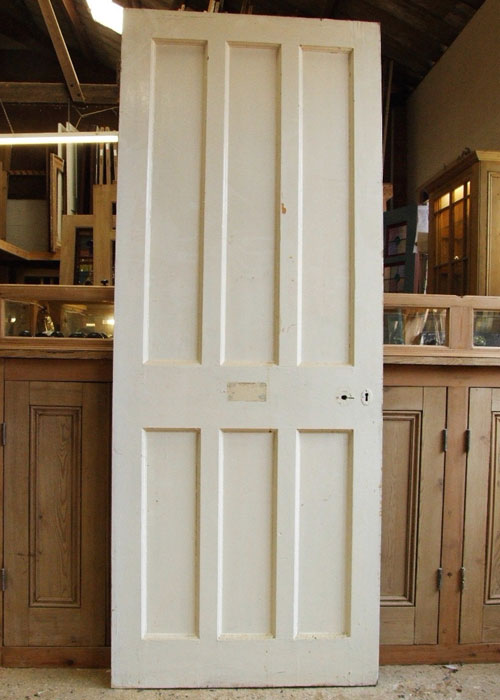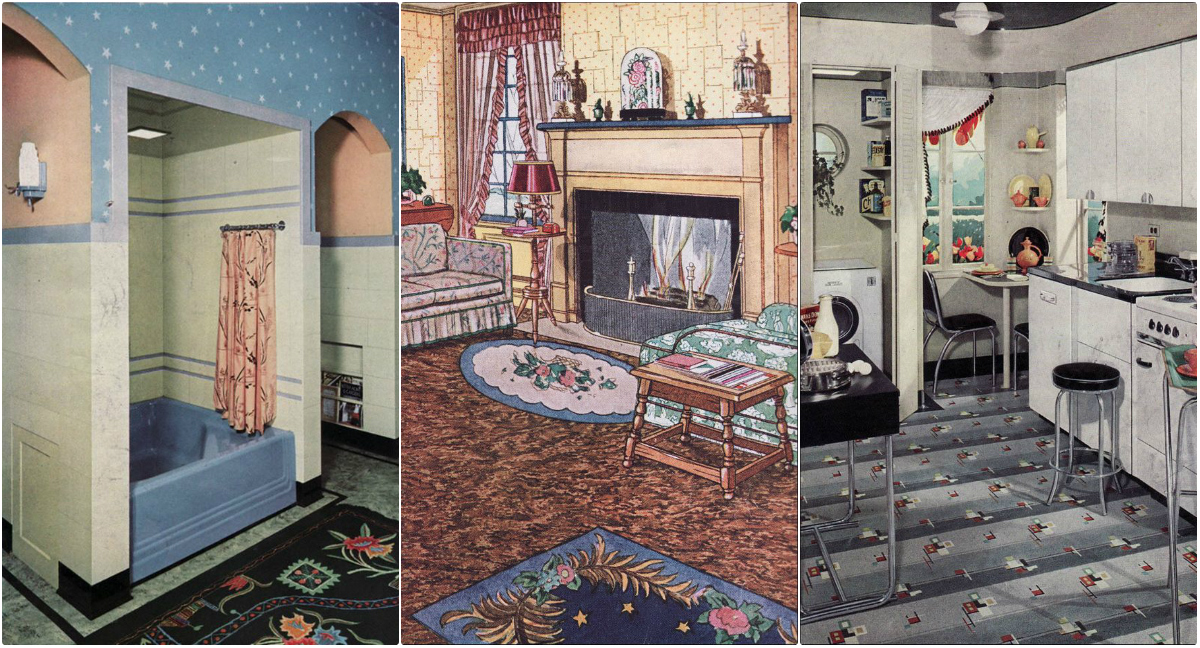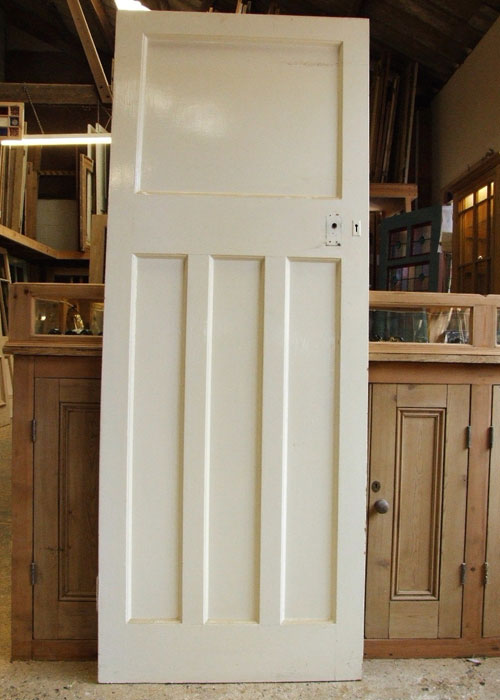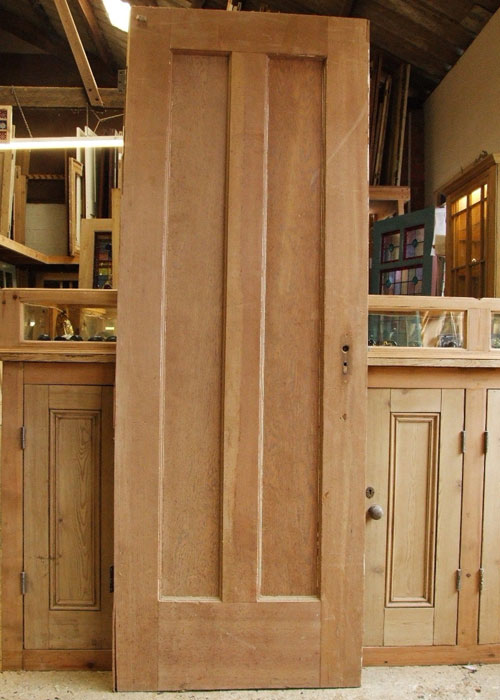Craftsman Interior Doors were popular during the 1930s, as they expressed the warm yet homey atmosphere of this era of furniture. Craftsman Interior Doors have also become popular again in 2020 due to their timeless and inviting appearance. Many of these doors feature five vertical panels with proportions that are tailored to fit the opening door with attention to detail, simple lines, and even intricate square and rectangular designs. During the 1930s, Craftsman Interior Doors were usually constructed of hardwood and possessed smaller panel sizes than those of the Art Deco styles that dominate many other houses. These doors typically had two or three panels as opposed to the multi-light glazed doors, and the designs could be further customized with inset glass, cross-panes, or stained panels. Furthermore, the door's trim and moulding could easily be stained to match other trims and moldings, allowing for the perfect door to coordinate with the rest of the room's aesthetics.1930 Craftsman Interior Doors
In contrast to Craftsman Interior Doors, the Art Deco Interior Doors were a common sight in the 1930s. These doors had a distinctive style, which often included geometric shapes, metal accents and designs, and Art Deco motifs. The doors themselves were constructed using premium hardwoods, with the two or four panel cladding usually covered with a metal sheath in a variety of finishes. Art Deco Interior Doors typically also featured hand-painted designs, multi-light glass panels, and symmetrical patterned trim. In the 1930s, these doors were often used to add a dramatic and sophisticated touch to the interior design of the home, and the Art Deco style continues to be popular today.1930 Art Deco Interior Doors
Tudor Interior Doors were very popular during the 1930s, as they were seen as a way to incorporate Tudor charm and timelessness into a home's interior design. These doors were usually constructed with milled or solid wood and consisted of charming horizontal panels that often included leaded glass, oval or diamond-shaped pendants, and embossed designs. These unique doors offered a look of timeless sophistication and style. The door trim was often milled at the door's corners and sometimes included a brick mold for decorative purposes. In addition, some of these doors were finished with an aged or distinguished look, while some were given a traditional whitewash finish to give them a more classic feel.1930 Tudor Interior Doors
The Modernist Interior Doors of the 1930s were characterized by their sleek and simple design. These doors typically consisted of two or four glazed panels, often with a combination of frosted glass and translucent or patchwork designs. Additionally, they were made of either solid wood or milled wood and were either stained or painted with minimalistic colors. Modernist Interior Doors were usually featureless as the focus was on the overall design. They were known for their bright, airy atmosphere and were often found in contemporary homes. Today, these doors are still very popular and can be seen in many modern homes.1930 Modernist Interior Doors
The Cottage Interior Doors of the 1930s often stood out from the rest for their cozy and welcoming aura. These doors consisted of two or three panels, with the two-panel doors forming an archway. They were made of solid wood or milled wood and are usually stained in light colors, such as white or beige, to add to their cozy atmosphere. These doors often featured intricate mouldings and designs, as well as stained glass windows and raised panels. Cottage Interior Doors could easily be matched with any cottage-style décor, making them an essential part of many homes in the 1930s.1930 Cottage Interior Doors
Bungalow Interior Doors in the 1930s were known for their distinctive and attractive look and were often used in bungalow-style homes. These doors were typically constructed of hardwood with two or four panels, featuring raised panels at the top and bottom. They were usually stained or painted in competent colors, such as green, yellow, or blue. These doors often came with intricate carvings and detailed trim, as well as redundant hinges and handles. The doors were typically painted in white, but could also be stained to give them a more rustic look. Bungalow Interior Doors were the perfect match for any home, whether traditional or modern.1930 Bungalow Interior Doors
The Spanish Colonial Interior Doors of the 1930s had a classic and evocative style. These doors were usually constructed from oak and other hardwoods, and typically consisted of four or five panels in a distinctive stile and rail construction. The panels of these doors were raised and featured a variety of intricate designs, such as cross-panes, polygonal shapes, and repeated medicine panels. In the 1930s, these doors could often be seen in houses with Spanish Colonial interiors, although they could also be made to match many other types of designs. Their timelessness and popularity continues to this day.1930 Spanish Colonial Interior Doors
Mediterranean Interior Doors were very popular in the 1930s, as they gave a unique and stylish look to a home. These doors were usually made of hardwood with two or five panels, featuring intricate designs with geometric motifs, metal accents, and carved panels. The door trim was often moulded around the door's edges and could be stained to match other existing trims in the home. These doors were known for their distinct and stylish Mediterranean look, which could easily be matched with many other décor motifs. Mediterranean Interior Doors remain popular today and are often seen in many Mediterranean-style homes.1930 Mediterranean Interior Doors
The Mission Interior Doors of the 1930s typically consisted of four or five panels, and featured unique designs with embossed wood, intricate motifs, and attractive trim. Mission Interior Doors were usually constructed of solid hardwood, making them robust and long-lasting. In addition, they were often stained with durable finish to protect the door from wear and tear. These unique doors were popular in houses that embraced a Mission-style interior, as they provided an inviting and rustic atmosphere. Today, Mission Interior Doors remain popular and can be seen in many homes.1930 Mission Interior Doors
The Craftsman Style Interior Doors of the 1930s often featured unique and distinctive designs that brought an atmosphere of warmth and comfort to the home. These doors usually consisted of two or four panels with prominent lines that followed the style of the Craftsman movement. They were often made of solid wood, with intricate detailing and embossing on the door frames. In addition, the trim around these doors was often milled and stained to match the rest of the room's finish materials. These doors were typically found in Craftsman-style homes and were able to seamlessly fit in with both the room's aesthetics and the home's exterior design.1930 Craftsman Style Interior Doors
French Provincial Interior Doors were often seen in the homes of the 1930s due to their elegant and welcoming atmosphere. These doors usually consisted of two or four panels and were often stained in natural colors, such as mahogany or walnut. The panels often featured intricate designs, such as fluted sides, beveled edges, and designs with rope edging. The trim around the doors was often milled and stained to match the door, the walls, and the other décor of the room. French Provincial Interior Doors provided a timeless and inviting atmosphere that is still popular today.1930 French Provincial Interior Doors
Adding Style To Your Home With 1930-Style Interior Doors
 As you begin to design and remodel your home, it's important to understand the different interior door styles available today. In this article, we'll focus on the wide range of
1930 style interior doors
that will add a unique and timeless element to your interior design.
As you begin to design and remodel your home, it's important to understand the different interior door styles available today. In this article, we'll focus on the wide range of
1930 style interior doors
that will add a unique and timeless element to your interior design.
Uniquely 1930
 The 1930s was a time of art deco-inspired designs that are often referred to as "streamline moderne." These designs were inspired by the times and often featured rounded corners, wood or metal accents, and visible hardware. Many of the
1930 style interior doors
showcase this streamlined look, from the flat surfaces to the rounded edges.
The 1930s was a time of art deco-inspired designs that are often referred to as "streamline moderne." These designs were inspired by the times and often featured rounded corners, wood or metal accents, and visible hardware. Many of the
1930 style interior doors
showcase this streamlined look, from the flat surfaces to the rounded edges.
Choosing a Material
 Wooden interior doors remain a classic, timeless choice for home owners. With this in mind, there are a variety of woods to choose from that can give your 1930 style interior door a unique and individualized touch. Some of the most popular options are mahogany, cherry, birch, and oak. In addition, plywood and fiberglass are also options for homes that wish to add a modern touch to their 1930s inspired decor.
Wooden interior doors remain a classic, timeless choice for home owners. With this in mind, there are a variety of woods to choose from that can give your 1930 style interior door a unique and individualized touch. Some of the most popular options are mahogany, cherry, birch, and oak. In addition, plywood and fiberglass are also options for homes that wish to add a modern touch to their 1930s inspired decor.
Accenting Interior Doors
 Depending on your preferred style, you can choose to dress up your
1930 style interior doors
with hardware and accents such as hinges, handles, and locksets. Brass is a popular choice for this style due to its classic aesthetic and ability to stand the test of time. You can also find vintage and antique pieces to add a truly unique look to your interior decor.
Depending on your preferred style, you can choose to dress up your
1930 style interior doors
with hardware and accents such as hinges, handles, and locksets. Brass is a popular choice for this style due to its classic aesthetic and ability to stand the test of time. You can also find vintage and antique pieces to add a truly unique look to your interior decor.
Adding the Perfect Finishing Touch
 Once you've chosen the materials you'd like to use on your
1930 style interior doors
, you can enhance your design by adding in the perfect finishing touches. A splash of paint that complements your color palette can go a long way in making your doors even more stylish, or you can opt for a natural stained finish on the wood of your choice.
With these design tips in mind, you'll be on your way to creating the look you desire for your 1930-style interior doors. From choosing the perfect material to adding the perfect finishing touches, these tips make it easy to create decor that stands out and is a true reflection of your personal style.
Once you've chosen the materials you'd like to use on your
1930 style interior doors
, you can enhance your design by adding in the perfect finishing touches. A splash of paint that complements your color palette can go a long way in making your doors even more stylish, or you can opt for a natural stained finish on the wood of your choice.
With these design tips in mind, you'll be on your way to creating the look you desire for your 1930-style interior doors. From choosing the perfect material to adding the perfect finishing touches, these tips make it easy to create decor that stands out and is a true reflection of your personal style.


















































































































